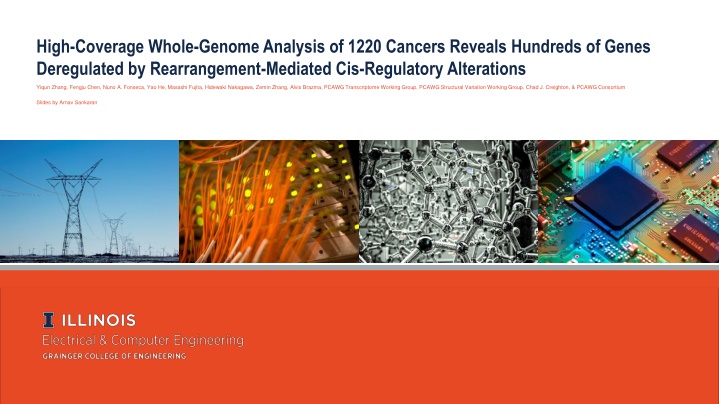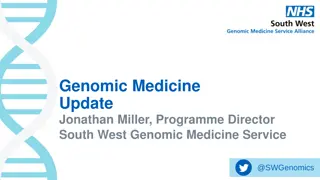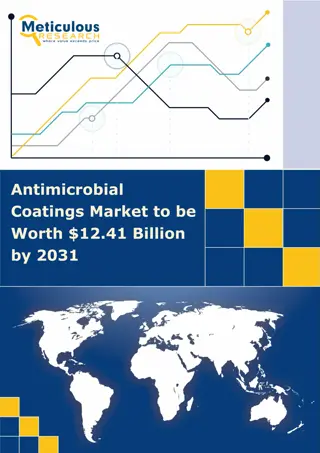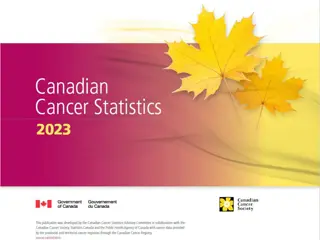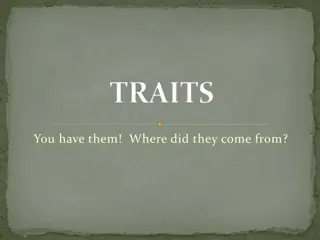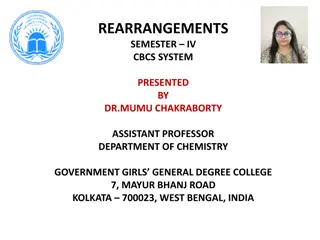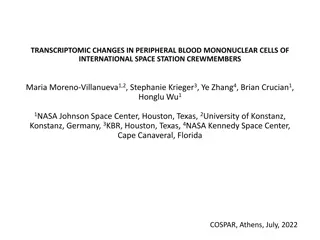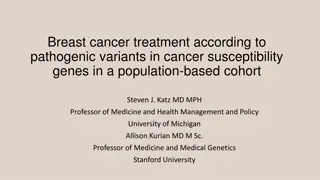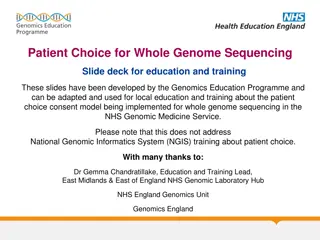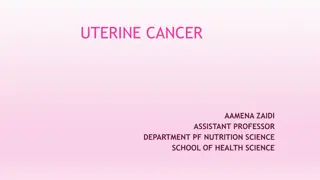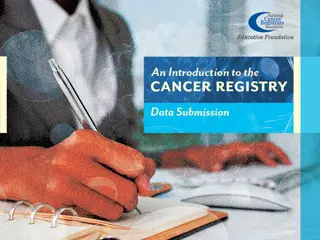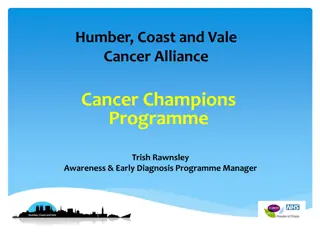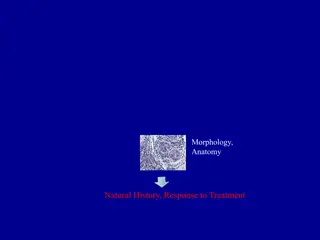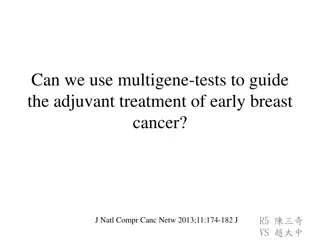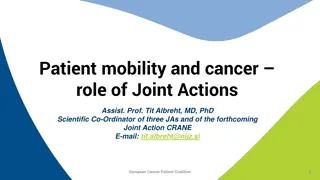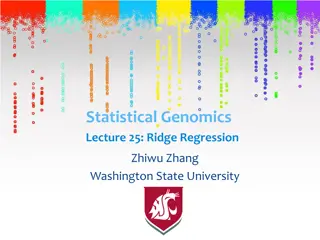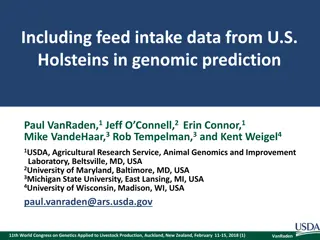Comprehensive Analysis of Cancer Genes Deregulated by Genomic Rearrangements
Investigation of somatic structural variation effects on gene expression in 1220 cancers reveals upregulation of key cancer genes such as TERT, MDM2, CDK4, and ERBB2. The study delves into the relationship between rearrangement-mediated cis-regulatory alterations and gene deregulation using a high-coverage whole-genome analysis approach on a large dataset from the PCAWG project, reanalyzing 2658 cancer cases across 38 tumor types. Insights from the study shed light on the impact of somatic structural variants and gene expression changes on tumor growth and development.
Download Presentation

Please find below an Image/Link to download the presentation.
The content on the website is provided AS IS for your information and personal use only. It may not be sold, licensed, or shared on other websites without obtaining consent from the author.If you encounter any issues during the download, it is possible that the publisher has removed the file from their server.
You are allowed to download the files provided on this website for personal or commercial use, subject to the condition that they are used lawfully. All files are the property of their respective owners.
The content on the website is provided AS IS for your information and personal use only. It may not be sold, licensed, or shared on other websites without obtaining consent from the author.
E N D
Presentation Transcript
High-Coverage Whole-Genome Analysis of 1220 Cancers Reveals Hundreds of Genes Deregulated by Rearrangement-Mediated Cis-Regulatory Alterations Yiqun Zhang, Fengju Chen, Nuno A. Fonseca, Yao He, Masashi Fujita, Hidewaki Nakagawa, Zemin Zhang, Alvis Brazma, PCAWG Transcriptome Working Group, PCAWG Structural Variation Working Group, Chad J. Creighton, & PCAWG Consortium Slides by Arnav Sankaran
Overview Investigation Somatic structural variation's effect on gene expression Is there upregulation of the gene? Determine if there is a correlation Results Key cancer genes expressions are effected by nearby SVs TERT, MDM2, CDK4, ERBB2, CD274, PDCD1LG2, and IGF2 Gene expression usually increases 2
Dataset PCAWG whole genomes project Whole genome sequencing From ICGC and TCGA datasets Reanalyzed to align to human genome (hs37d5) 2658 cancer cases 38 tumor types 1220 cases had gene expression profiles Investigation is performed on these elements of the dataset 3
Somatic Structural Variant Variant Mutations that arise through rearrangements, duplications, or deletions of segments of DNA Breakpoint See image https://bionanogenomics.com/wp-content/uploads/2017/07/Technology_supportGraphic_SV_TYPES_revised.jpg 4
Gene Expression & Upregulation Expression Process of transcribing DNA into mRNA More mRNA leads to increased protein translation Upregulation The increased transcribing of DNA into mRNA Upregulation is relative to healthy cells log2((gene expression) / (healthy gene expression)) This often is one of the initiators of tumor growth 5
Gene Promotors & Enhancers Promotor A region of DNA which leads to the transcription of coding regions Upregulation is often a result of mutations in the promotor Enhancer A region of DNA which can be bound by a protein When bound transcription increases and causes upregulation 6
SV Breakpoint Analysis Consider SV breakpoints that are close to the gene Location vs Significant Genes 600 SV Event Location # of significant genes 500 0 20kb downstream 302 400 Within the Gene 518 300 0 20kb upstream 384 200 20 50kb upstream 416 100 50 100kb upstream 496 0 0-20 downstream Within gene 0-20 upstream 20-50 upstream 50-100 upstream # of genes 7
SV Breakpoint Analysis SV event effect on regulation 95% of genes expression changes were upregulation # of genes identified is significant; not due to randomness Random data yielded only ~30 significant genes Significant genes were found even further away Including in both upstream and downstream directions 8
SV Breakpoint Analysis Distance from gene doesn t impact distribution 9
Key Driver Genes Significant Regions Genes Increased expression TERT, MYC, MDM2, CDK4, ERBB2, CD274, PDCD1LG2, IGF2 Decreased expression PTEN, STK11, KEAP1, TP53, RB1, SMAD4 These are likely tumor suppressant genes 10
Key Driver Genes Significant Regions Locations Greatly vary falling into all the buckets described earlier Specific genes tend to more affected by some buckets 11
SV Event Impact on Cancer Cases Observed SV events impact significant portion of cases 2-5% of cases across all type of cancer SVs involving the above categories of genes would potentially impact a substantial fraction of cancer cases, e.g., on the order of 2 5% of cases across various type Page 4 12
DNA Methylation vs Gene Expression Expectations Inverse trend between DNA methylation and gene expression Observations Expectations hold when considering full 8256 gene dataset Weaker inverse trend for set of 263 genes with SV event 13
Clinical Impact Personalized medicine Traditionally focusses on mutations in coding regions New understanding about the impact of genomic rearrangements Now possible due to whole genome sequencing Enhances ability to understand individual cancer cases Allow clinicians to provide better treatment for the individual Brings us closer to fully personalized treatments for cancer 14
Study Limitations Correlation vs causation Focuses on SV and gene expression correlation Does not investigate the exact causation process There are many possible causation explanations Enhancer hijacking Topological associating domains disruption 15
Future Work Understand the exact causation process Investigate why this correlation exists Determine if there is a single causation process Maybe different genes produce the same correlation for different reasons Might be possible to set of causes and classify genes into buckets 16
Related Work Chromatin folding domain disruptions Disruption of chromatin folding domains by somatic genomic rearrangements in human cancer Paper from Tuesday Some (small percentage) TAD boundary changes modify gene expression Can SVs cause those disruptions to TADs? This might be one causation explanation 17
Related Work Somatic SV impact on DNA methylome Global impact of somatic structural variation on the DNA methylome of human cancers Genes and associated CpG islands which have a nearby somatic SV are observed to have altered expression and DNA methylation Association is generally promotor-associated Overall a DNA methylation decrease is associated with cancer Zhang, Y., Yang, L., Kucherlapati, M. et al. Global impact of somatic structural variation on the DNA methylome of human cancers. Genome Biol 20, 209 (2019). https://doi.org/10.1186/s13059-019-1818-9 18
Open Questions How far away from a gene can an SV be and still be impactful to the expression of the gene? How can we determine that the change in expression was not caused by another SV that was closer? 19
Open Questions There are a lot of factors, some of which are unknown, that play into gene expression. Is it reasonable for us to do a follow-up causation study? 20
Open Questions Since proving direct biological causation is difficult, let s borrow from the deep learning paper and take a computation inference approach. Let SVs be the input features and the outputs be the gene expression changes. Would this help us better infer the subset of SVs that impact gene expression? 21
